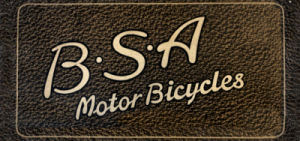


The 1929 L29 Sidevalve model differes considerably to the 1928 machine.
A reliable "go anywhere" solo mount that holds the road and steers wonderfully well. When fitted with a B.S.A. No. 9, 9c, or 14 sidecar, for which purpose the frame has special lugs, it makes a light, comfortable, and economical combination outfit. This model should appeal to the rider who prefers the simplicity of the side-valve engine.
Engine.
Single cylinder, 3.49 h.p., 72 x 85½ mm. bore and stroke (349 c.c.). The roller has big-end bearings. The engine has mainshaft driving side mounted on ball bearing, plain bearing on gear side. Aluminium alloy piston, silent timing gear, silencer of large capacity giving quiet exhaust without loss of efficiency.
Ignition, Magneto, and Carburettor.
The carburettor is an Amac, but a special carburettor fitted with air cleaner can be fitted as an extra. The magneto is driven by an adjustable chain in an aluminium dust-proof case.
Lubrication.
Gravity feed to mechanical pump of improved type, then to sight feed on timing case, feeding to crankcase. A hand pump is also fitted for emergency use. Oil is supplied to the primary chain by depressing a spring by-pass valve on the sight feed. Hubs, fork links, etc., are fitted with grease-gun nipples.
Transmission.
Front chain, ½ in. x .305 in. Rear chain, 5/8 in. x ¼ in. The front drive is enclosed in a two-part chain case, and the rear drive is protected by an efficient guard. A cam-faced cush drive is fitted to the engine shaft. For gear ratios see page 69.[1]
Clutch.
This is contained in a large chain wheel, and is of the floating dry-plate type. Controlled by means of a lever on left of handlebar, with large diameter cable.
Gear-box.
B.S.A. Three-speed. All gears constantly in mesh, Kick-starter mechanism is enclosed in gear-box. Inclined change-speed lever on right side of tank. Screw adjustment of box position for accurately setting chain tension.
Frame and Spring Fork.
The frame is designed to give low riding position. Weldless steel tubing and forged steel lugs throughout. Headlug of continuous type giving great strength. Fitted with special lugs to take B.S.A. sidecars. A strong carrier is fitted. The spring fork is of the strengthened B.S.A. type, fitted with a taper compression spring and shock absorbers.
Handlebar.
Adjustable, mounted behind steering head, with forward bend at. centre and back sweep at ends. Reversible for sports use. Has long rubber grips.
Tank.
Tapered type supported by brackets brazed to the frame. Filler caps, unleakable, secured with bayonet joint and chain ; a combined priming and petrol tap. Capacity: petrol, 1½ gals. ; oil, 3½ pints.
Wheels and Tyres.
Heavy gauge rim wheels, 21 in. x 2¼ in., enamelled. Taper roller bearings to rear hub. Tyres: 27 in. x 2.75 in., Dunlop cord, wired on, or 20 in. x 3.25 in., wired on with special front mudguard extra.
Brakes.
Both of the internal expanding type. Front, 5½ in. diameter, operated by lever on right handlebar. Rear, 7 in. diameter, operated by a toe pedal on independent fulcrum on right side of machine. Grease-gun nipples fitted to the cam spindles.
Saddle and Mudguards.
Terry spring seat, lightweight saddle. Brooks supple seat B.189/1, if specified. Mudguards: rear, 6 in. wide of plain section, front fitted with side wings and splash attachment.
Footrests and Stands.
Back stand kick-up. Front stand rigidly secured to guard. The footrests are adjustable.
Notes
1. More pages from this book are available at Craig Howell's Flickr pages. Craig Howell
Source: Book of the BSA by Waysider. Pitmans, 1928.